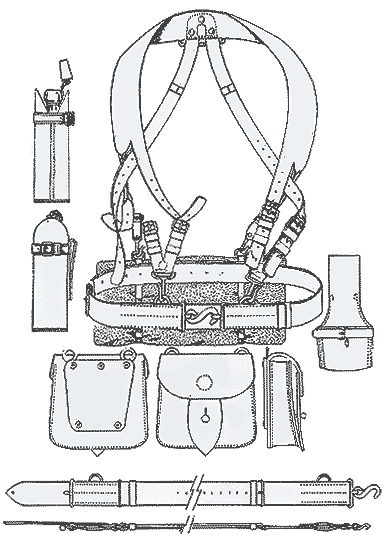Uniforms & Equipment
Oliver Pattern Equipment
 Oliver Equipment, Pattern 1899. Basic components
including waistbelt, ammunition pouch, yoke and braces, bayonet frog,
waterbottle and carrier, and greatcoat.
Oliver Equipment, Pattern 1899. Basic components
including waistbelt, ammunition pouch, yoke and braces, bayonet frog,
waterbottle and carrier, and greatcoat.The load-bearing equipment worn by the Canadians in South Africa was their own Oliver Pattern. Designed by J.W. Oliver, a surgeon serving with the British Army in the Red River Expedition of 1870, it was intended to keep a soldier self-sufficient on the march over long periods and was constructed entirely of brown leather. Although rejected by the British Army, it did catch the eye of senior officials in the Canadian Militia, who recommended its adoption in 1883. It did not go into production until 1898, however.
The equipment consisted of a waistbelt with brass snake buckle, an eighty-round cartridge pouch, bayonet frog, pint water bottle and carrier, canvas valise (knapsack), mess tins and canvas cover, and a set of braces, with shoulder yoke, to carry the weight. A white canvas haversack with a shoulder strap and a set of leather greatcoat straps also formed part of the equipment.
In South Africa, the Canadians experienced a number of problems with their Oliver Pattern equipment. First, the pint water bottle proved much too small and fragile for serious military campaigning, and the troops jettisoned it soon after their arrival at Cape Town in favour of the larger British Mark IV pattern, made of enamelled steel. The place of the ammunition pouch in front of the abdomen also caused problems. When fully loaded with eighty cartridges it was heavy and unbalanced a man's gait. Moreover, when forced to the ground to take cover from enemy fire, the pouch dug into a man's stomach. Reloading from such a position was also difficult, with the pouch between the soldier and the ground. The problem was relieved to some degree by the adoption of hundred-round web bandoliers worn over the shoulder.
The members of Canadian mounted units in South Africa wore a variation of the Oliver Pattern Equipment, consisting of a belt, bayonet, and haversack. As mounted troops they also carried a holster and a leather ammunition bandolier. The Canadian-made holster held a Colt .455 New Service Revolver. The bandolier was of the Orndorff pattern worn by British mounted units, and consisted of a wide leather belt that was draped over the left shoulder, and held under the right arm. It could carry fifty rounds of .303 ammunition in five separate pouches.
Despite its problems, the Oliver Pattern Equipment remained in use for the duration of the South African War. Canadian soldiers even wore it during the First World War, where it proved entirely inadequate to the conditions of service and was replaced by British-issue web gear.
